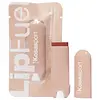Andalou Naturals Age Defying Ultra Sheer Daily Defense Facial Lotion SPF 18 Versus Kosas LipFuel Hyaluronic Acid Lip Balm
What's inside
What's inside
 Key Ingredients
Key Ingredients

 Benefits
Benefits

 Concerns
Concerns

 Ingredients Side-by-side
Ingredients Side-by-side

Aloe Barbadensis Leaf Juice
Skin ConditioningWater
Skin ConditioningGlycerin
HumectantGlyceryl Stearate
EmollientStearic Acid
CleansingSorbitan Sesquioleate
EmulsifyingStearyl Alcohol
EmollientGlyceryl Stearate Citrate
EmollientHelianthus Annuus Seed Oil
EmollientMalus Domestica Fruit Cell Culture Extract
Skin ConditioningPanthenol
Skin ConditioningAllantoin
Skin ConditioningTocopherol
AntioxidantSodium Hyaluronate
HumectantResveratrol
AntioxidantUbiquinone
AntioxidantMagnesium Ascorbyl Phosphate
AntioxidantGlycyrrhiza Glabra Root Extract
BleachingLaminaria Digitata Extract
Skin ProtectingChamomilla Recutita Flower Extract
MaskingCalendula Officinalis Flower Extract
MaskingRosa Canina Fruit Oil
EmollientCamellia Sinensis Leaf Extract
AntimicrobialPhenethyl Alcohol
MaskingEthylhexylglycerin
Skin ConditioningCitrus Tangerina Peel Oil
MaskingCitrus Aurantium Dulcis Peel Oil
MaskingAloe Barbadensis Leaf Juice, Water, Glycerin, Glyceryl Stearate, Stearic Acid, Sorbitan Sesquioleate, Stearyl Alcohol, Glyceryl Stearate Citrate, Helianthus Annuus Seed Oil, Malus Domestica Fruit Cell Culture Extract, Panthenol, Allantoin, Tocopherol, Sodium Hyaluronate, Resveratrol, Ubiquinone, Magnesium Ascorbyl Phosphate, Glycyrrhiza Glabra Root Extract, Laminaria Digitata Extract, Chamomilla Recutita Flower Extract, Calendula Officinalis Flower Extract, Rosa Canina Fruit Oil, Camellia Sinensis Leaf Extract, Phenethyl Alcohol, Ethylhexylglycerin, Citrus Tangerina Peel Oil, Citrus Aurantium Dulcis Peel Oil
Ricinus Communis Seed Oil
MaskingCaprylic/Capric Triglyceride
MaskingEuphorbia Cerifera Cera
AstringentBis-Diglyceryl Polyacyladipate-2
EmollientMica
Cosmetic ColorantSilica
AbrasiveOctyldodecanol
EmollientLanolin Oil
EmollientJojoba Esters
EmollientPentaerythrityl Tetraethylhexanoate
EmollientHelianthus Annuus Seed Cera
EmollientBeeswax
Emulsion StabilisingCopernicia Cerifera Wax
Camellia Oleifera Seed Oil
Skin ConditioningTheobroma Cacao Seed Butter
EmollientVitis Vinifera Seed Oil
EmollientAcacia Decurrens Flower Cera
EmollientButyrospermum Parkii Butter
Skin ConditioningCaprylyl Glycol
EmollientCarthamus Tinctorius Seed Oil
MaskingEthylhexyl Palmitate
EmollientEthylhexylglycerin
Skin ConditioningGlucomannan
Skin ConditioningHelianthus Annuus Extract
EmollientMangifera Indica Seed Butter
Skin ConditioningMentha Arvensis Leaf Oil
MaskingOryza Sativa Bran Extract
Skin ConditioningPersea Gratissima Oil
Skin ConditioningPolyglycerin-3
HumectantRosa Canina Fruit Oil
EmollientRosmarinus Officinalis Leaf Extract
AntimicrobialSimmondsia Chinensis Seed Oil
EmollientSodium Hyaluronate
HumectantTocopherol
AntioxidantTocopheryl Acetate
AntioxidantTrihydroxystearin
Skin ConditioningLimonene
PerfumingCI 77891
Cosmetic ColorantCI 15850
Cosmetic ColorantCI 77491
Cosmetic ColorantCI 77492
Cosmetic ColorantCI 77499
Cosmetic ColorantCI 73360
Cosmetic ColorantRicinus Communis Seed Oil, Caprylic/Capric Triglyceride, Euphorbia Cerifera Cera, Bis-Diglyceryl Polyacyladipate-2, Mica, Silica, Octyldodecanol, Lanolin Oil, Jojoba Esters, Pentaerythrityl Tetraethylhexanoate, Helianthus Annuus Seed Cera, Beeswax, Copernicia Cerifera Wax, Camellia Oleifera Seed Oil, Theobroma Cacao Seed Butter, Vitis Vinifera Seed Oil, Acacia Decurrens Flower Cera, Butyrospermum Parkii Butter, Caprylyl Glycol, Carthamus Tinctorius Seed Oil, Ethylhexyl Palmitate, Ethylhexylglycerin, Glucomannan, Helianthus Annuus Extract, Mangifera Indica Seed Butter, Mentha Arvensis Leaf Oil, Oryza Sativa Bran Extract, Persea Gratissima Oil, Polyglycerin-3, Rosa Canina Fruit Oil, Rosmarinus Officinalis Leaf Extract, Simmondsia Chinensis Seed Oil, Sodium Hyaluronate, Tocopherol, Tocopheryl Acetate, Trihydroxystearin, Limonene, CI 77891, CI 15850, CI 77491, CI 77492, CI 77499, CI 73360
 Reviews
Reviews

Ingredients Explained
These ingredients are found in both products.
Ingredients higher up in an ingredient list are typically present in a larger amount.
Ethylhexylglycerin (we can't pronounce this either) is commonly used as a preservative and skin softener. It is derived from glyceryl.
You might see Ethylhexylglycerin often paired with other preservatives such as phenoxyethanol. Ethylhexylglycerin has been found to increase the effectiveness of these other preservatives.
Rosehip Oil is a non-fragrant plant oil. Rosehips are a fruit from a rose bush and are edible. This oil has skin conditioning and hydrating properties.
Rosehip contains Vitamin C, Vitamin E, fatty acids and linolenic acids. These nourish your skin barrier. Having hydrated skin may help reduce the appearance of fine-lines and wrinkles.
Another great component of Rosehip Oil is Vitamin A, or retinol. Vitamin A encourages your skin to create more collagen.
Rosehip oil may help with reducing pigmentation. The lycopene and beta-carotene have skin-lightening properties. However, more studies are needed to confirm this.
Learn more about Rosa Canina Fruit OilSodium Hyaluronate is hyaluronic acid's salt form. It is commonly derived from the sodium salt of hyaluronic acid.
Like hyaluronic acid, it is great at holding water and acts as a humectant. This makes it a great skin hydrating ingredient.
Sodium Hyaluronate is naturally occurring in our bodies and is mostly found in eye fluid and joints.
These are some other common types of Hyaluronic Acid:
Learn more about Sodium HyaluronateTocopherol (also known as Vitamin E) is a common antioxidant used to help protect the skin from free-radicals and strengthen the skin barrier. It's also fat soluble - this means our skin is great at absorbing it.
Vitamin E also helps keep your natural skin lipids healthy. Your lipid skin barrier naturally consists of lipids, ceramides, and fatty acids. Vitamin E offers extra protection for your skin’s lipid barrier, keeping your skin healthy and nourished.
Another benefit is a bit of UV protection. Vitamin E helps reduce the damage caused by UVB rays. (It should not replace your sunscreen). Combining it with Vitamin C can decrease sunburned cells and hyperpigmentation after UV exposure.
You might have noticed Vitamin E + C often paired together. This is because it is great at stabilizing Vitamin C. Using the two together helps increase the effectiveness of both ingredients.
There are often claims that Vitamin E can reduce/prevent scarring, but these claims haven't been confirmed by scientific research.
Learn more about Tocopherol